Intro
In the current digital era, it is crucial for companies and website owners to have a strong online presence. Making sure that potential consumers and clients can find your website and content when they conduct internet searches for pertinent keywords is an important part of accomplishing this.
Search engine optimization (SEO) is useful in this situation. A variety of tactics and strategies are used in SEO to raise the position of your website in search engine results pages (SERPs), increasing the likelihood that users will find and visit your site.
Making your website and content search engine friendly may raise brand awareness, draw in more relevant traffic, and eventually enhance conversions and sales. The essential elements of SEO will be covered in this article, along with advanced SEO strategies like local SEO, voice search optimization, and featured snippets optimization. These strategies include keyword research, on-page optimization, off-page optimization, content creation, and all other forms of optimization.
Also, we'll give you pointers and resources to help you raise your internet exposure and search engine rankings. Understanding and employing efficient SEO tactics will assist you in achieving your online objectives and expanding your organization, whether you are a small business owner or a website administrator.
Keyword research
Keyword research is a fundamental aspect of SEO that involves analyzing and selecting the right keywords and phrases to target in order to increase website traffic and visibility in search engine results pages (SERPs).
A. Definition of Keyword Research
Finding and analyzing the precise words and phrases that people use to search for information online is known as keyword research. Finding keywords with a large search volume and little competition is the aim of keyword research in order to make it simpler for your website to rank higher in SERPs.
B. Importance of Keyword Research in SEO
The effectiveness of any SEO plan depends on the identification of the most valuable and relevant keywords for a given industry or niche: be it an SEO strategy for colleges, healthcare brands, SaaS companies, and other industries that rely on higher web visibility for enrollments/leads.. You may produce content that is optimized for those keywords and draw more relevant traffic to your website by knowing the words and phrases that people use when looking for goods, services, or information relating to your company.
C. Techniques for Finding High-Traffic, Low-Competition Keywords
There are various techniques and tools that businesses and website owners can use to find high-traffic, low-competition keywords, including:
Brainstorming
- Consider the perspective of your target audience while coming up with prospective keywords and phrases. Think about the terms and expressions people would employ to find goods and services similar to yours. You can use this to find valuable and pertinent keywords to target.
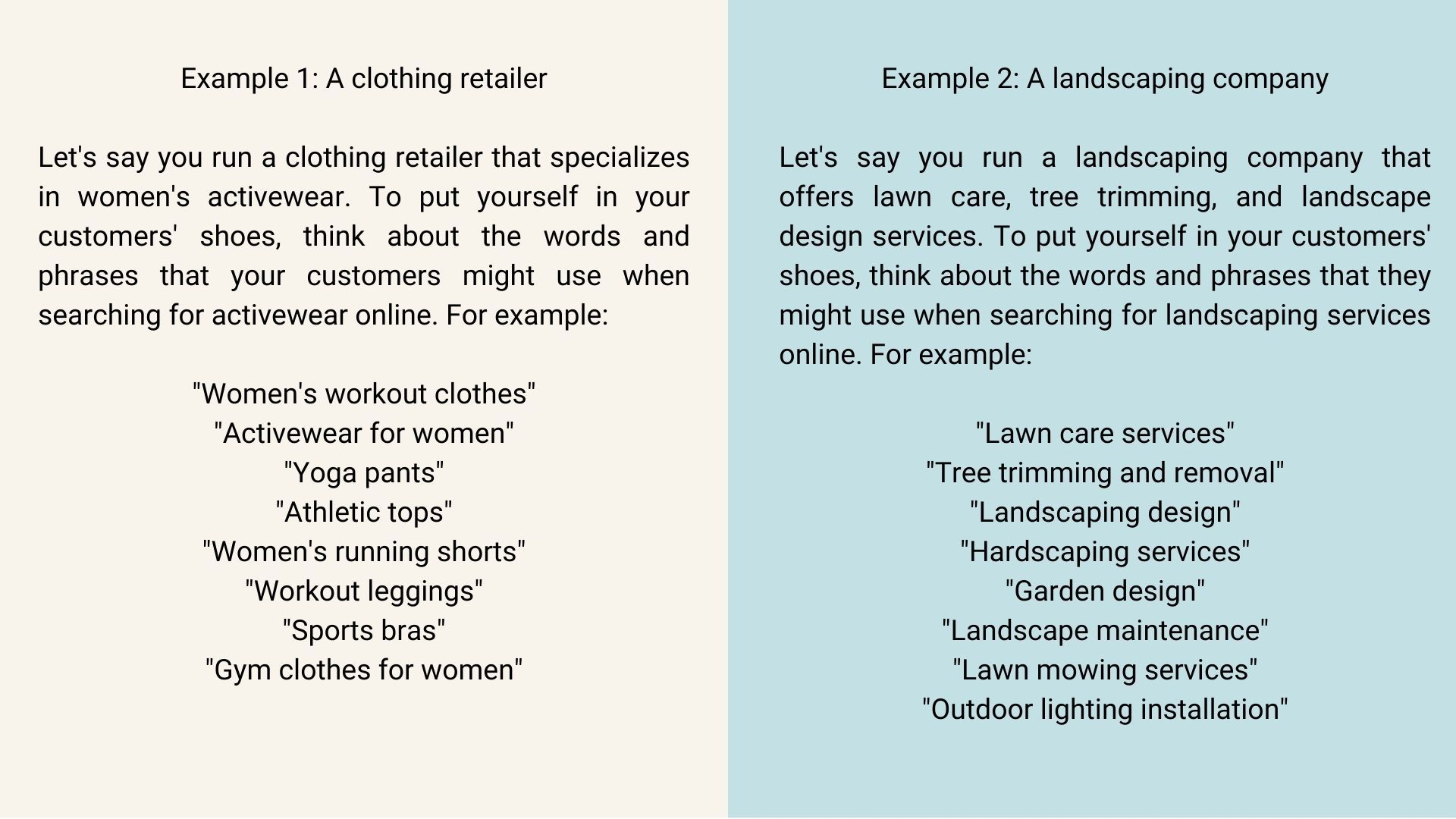
- Employ a thesaurus: When coming up with keywords, a thesaurus can be a useful resource. You can use it to find synonyms and related words that you would not have otherwise considered.
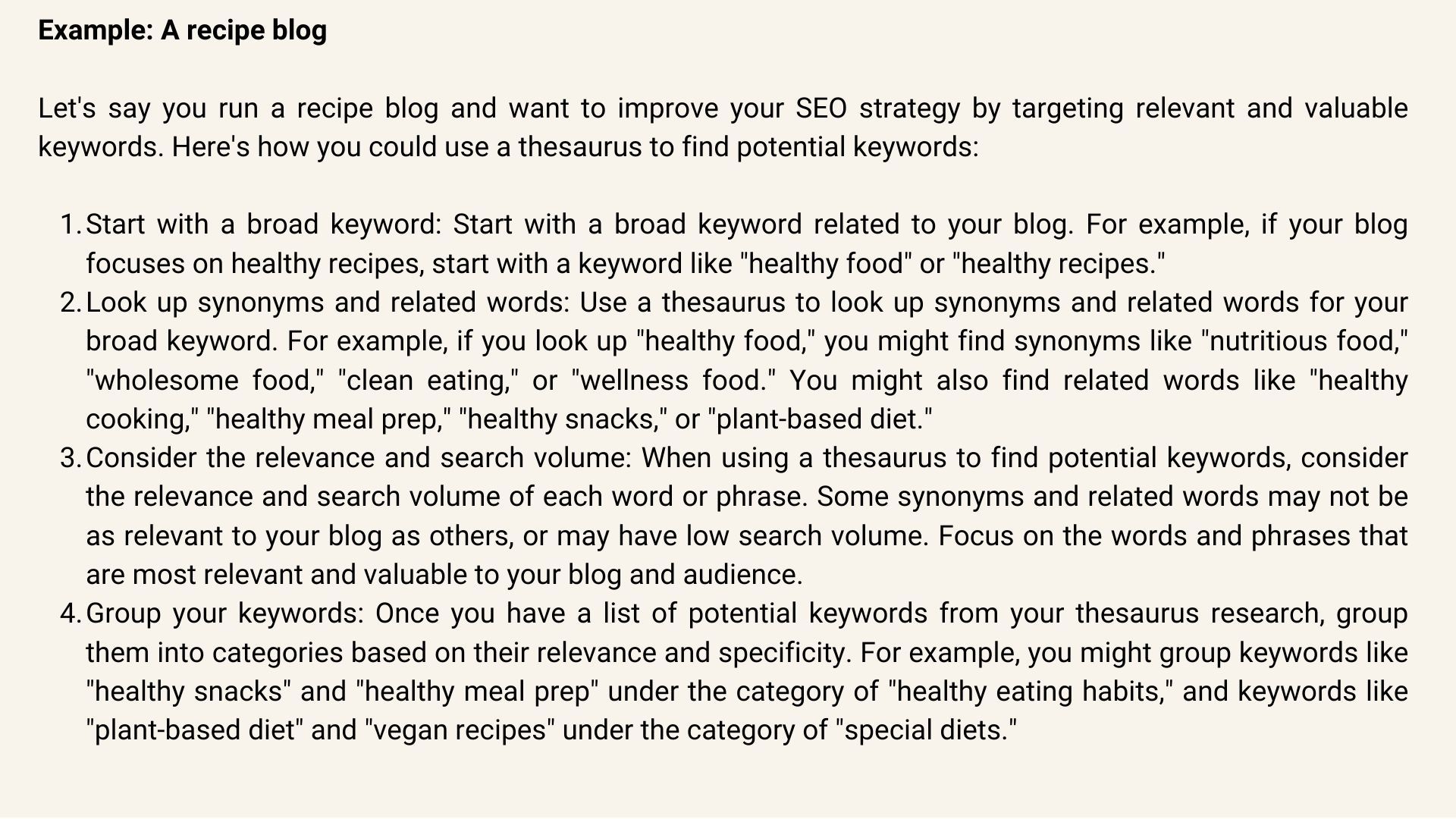
- Query your clients: If you already have a customer base, think about getting in touch with them and finding out what keywords and phrases they use to find goods and services similar to yours. You may learn a lot from this about the vocabulary and lingo that your clients use.
Use a similar email to the one below:

- Think about long-tail keywords. Long-tail keywords are longer, more precise keyword phrases with lower search traffic but perhaps easier ranking potential. Think about including long-tail keywords in your list when brainstorming.
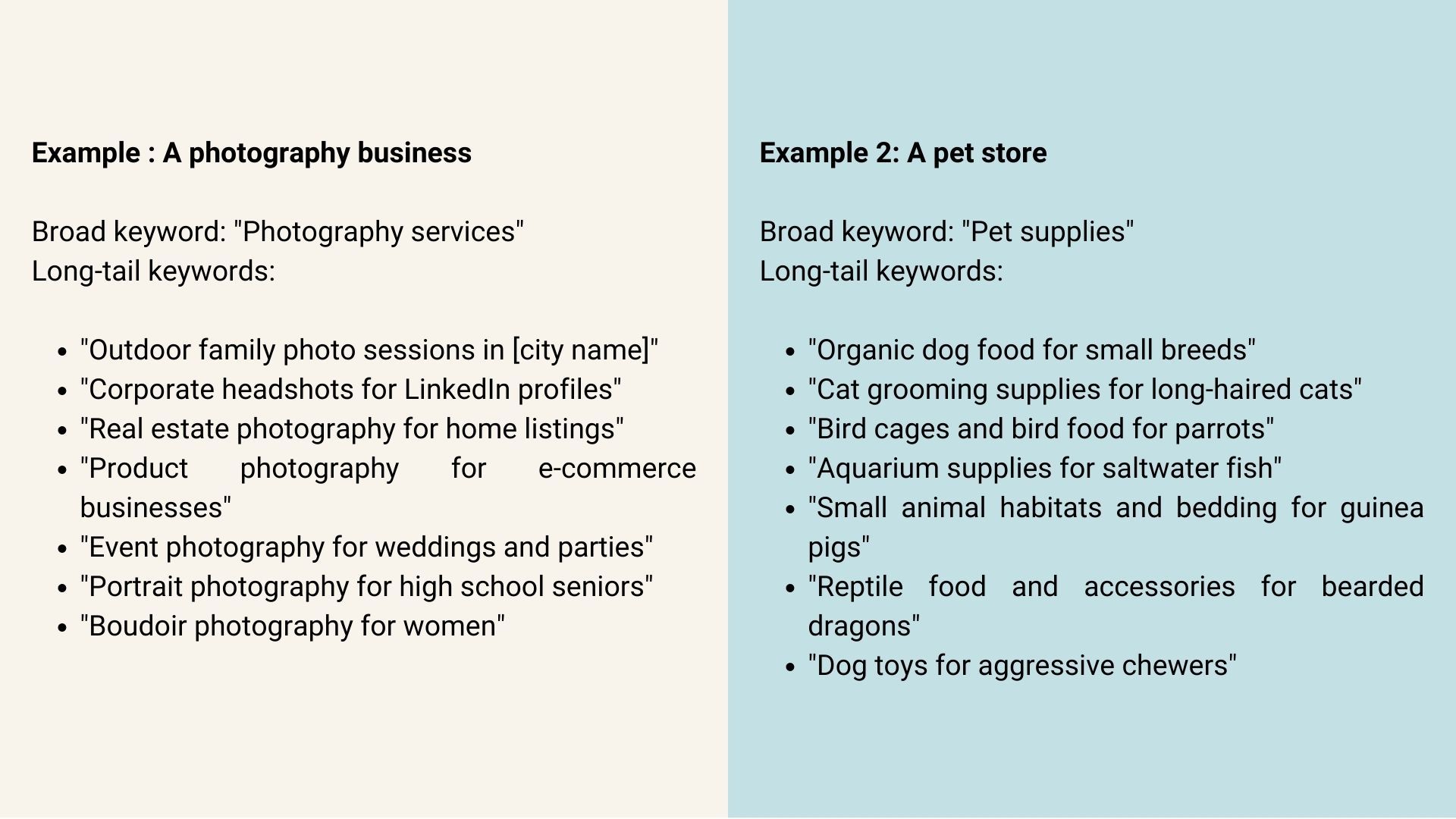
- Organize your keywords: As soon as you get a list of potential keywords, classify them according to their relevance and level of specificity. This can assist you in prioritizing the keywords you should focus on for your SEO and content strategies.
Competitor Analysis
- Determine your rivals: Begin by figuring out who your industry's or niche's top rivals are. These could be companies or websites that serve the same market as you and offer comparable goods or services.
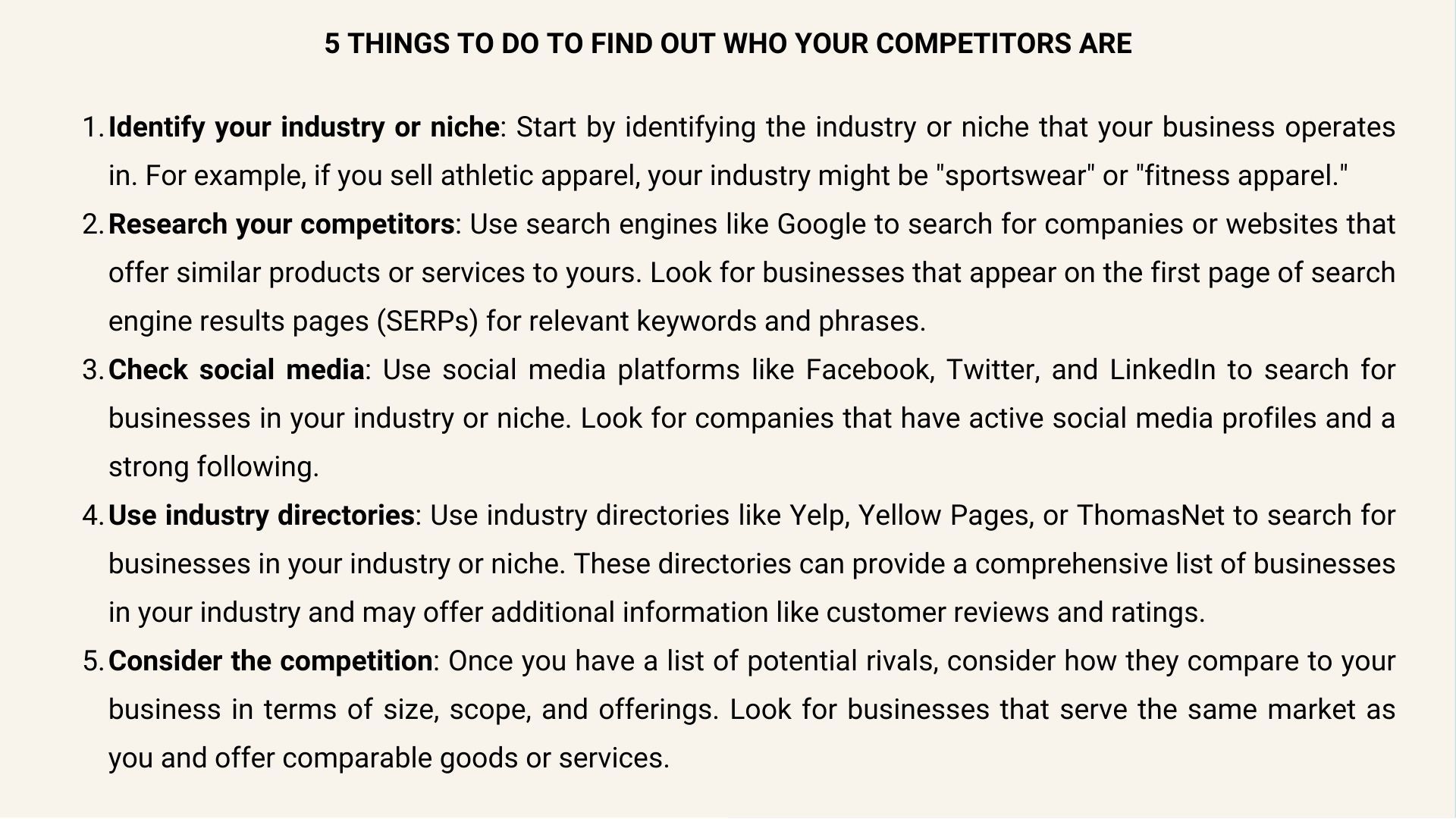
- Investigate their content Analyze the material on your competitors' websites and social media platforms once you've found them. Look for the words and phrases they are using in their marketing and content to find them.
- When examining the material of your rivals, keep an eye out for any holes in their keyword targeting. Do they not target any important and worthwhile keywords that you may use in your own content?
- While examining the keywords of your rivals, take into account the level of competition for each keyword. Are there any terms you may target to obtain a competitive edge that has a large search volume and little competition?
Google Autocomplete
- When utilizing Google Autocomplete to uncover new keywords, start with a broad keyword associated with your company or sector. For instance, if you own a fitness center, begin your search with the word "fitness" or "exercise."
- Pay close attention to the advice: Pay attention to the suggestions that Google makes as you begin typing your wide keyword in the Autocomplete dropdown menu. You can use these ideas to generate fresh keyword and phrase targets for your SEO strategy.
- Find long-tail keywords by using Google Autocomplete. Long-tail keywords are longer, more precise keyword phrases that normally receive less search traffic but may be simpler to rank for. With the Autocomplete suggestions, look for long-tail keywords that are pertinent to your organization or sector.
- Consider varying: Try different iterations of your wide keyword in Google Autocomplete to see what suggestions appear. Try options like "fitness classes," "fitness training," or "fitness programs" to see what results you get, for instance, if you manage a fitness studio.
- Utilize related searches: After entering your broad term and reviewing the Autocomplete suggestions, scroll to the bottom of the search results page and have a look at the "related searches" area. You can use these linked searches to generate new keyword and phrase ideas for your SEO strategy.
If you are looking to jump into the world of influencer marketing connect with Social Cat for a complimentary trial or book a demo and learn how to work with micro-influencers to boost your brand.
On-page SEO
On-page optimization is the process of improving a website's content and architecture to increase its visibility and attractiveness to both visitors and search engines. This entails enhancing content for relevant keywords and delivering a great user experience by optimizing titles, meta descriptions, header tags, and content.
On-page optimization is a crucial component of SEO because it aids in search engines' comprehension of your website's content and its suitability for particular search queries. Your website's visibility and ranking in search engine results pages can be enhanced by optimizing your on-page features, which may result in an increase in the natural traffic to your website.
Guidelines for making header tags, meta descriptions, and content both user- and search engine-friendly: Your on-page components can be optimized for SEO using a variety of methods, such as:
Start with keyword research
Begin by conducting keyword research to identify the most relevant and valuable keywords and phrases for your website and target audience.
Incorporate keywords into titles and meta descriptions
Once you have identified relevant keywords, incorporate them into your titles and meta descriptions to make them more appealing and relevant to both users and search engines. Keep in mind that titles and meta descriptions should accurately reflect the content of your pages and encourage users to click through to your website.
Use header tags to structure your content
Use header tags (H1, H2, H3) to structure your content and make it more scannable and easy to read for both users and search engines. Incorporate relevant keywords into your header tags to improve the relevance and visibility of your content. Header tags (H1, H2, H3) are HTML tags that indicate the hierarchy and structure of your content. By using header tags, you can help search engines understand the main topics and subtopics.
Write high-quality and informative content
Write high-quality and informative content that addresses the needs and interests of your target audience while incorporating relevant keywords naturally and strategically. Avoid keyword stuffing or overusing keywords, as this can result in a penalty from search engines. Ensuring quality also requires you to keep content unique. Plagiarized content doesn’t go unnoticed by search engines. Your website may get deranked or penalized for plagiarism.
So, keep an eye out for accidental as well as intentional plagiarism and assess your content for uniqueness before publishing it. A free plagiarism checker with an extensive database is all you need for this task. Such a tool will easily identify plagiarized sections by comparing your content with billions of sources and flag it. You can simply modify the content and eliminate plagiarism to ensure its uniqueness and quality.
Proofread and edit your content
While creating content, you may need to correct several grammatical mistakes that can hurt content credibility and affect SEO rankings. Before publishing the content, it is essential to thoroughly proofread it and resolve all grammar issues, including typos, sentence structure, punctuation, and syntax. A manual grammar check is not as simple as we consider, so you can get help from an online grammar checker that can help you make your content 100% error-free.
Optimize images and other media files
Optimize images and other media files with relevant alt tags and descriptive file names to make them more accessible to search engines and improve user experience. Incorporate relevant keywords into your alt tags and file names to improve the relevance and visibility of your media files.
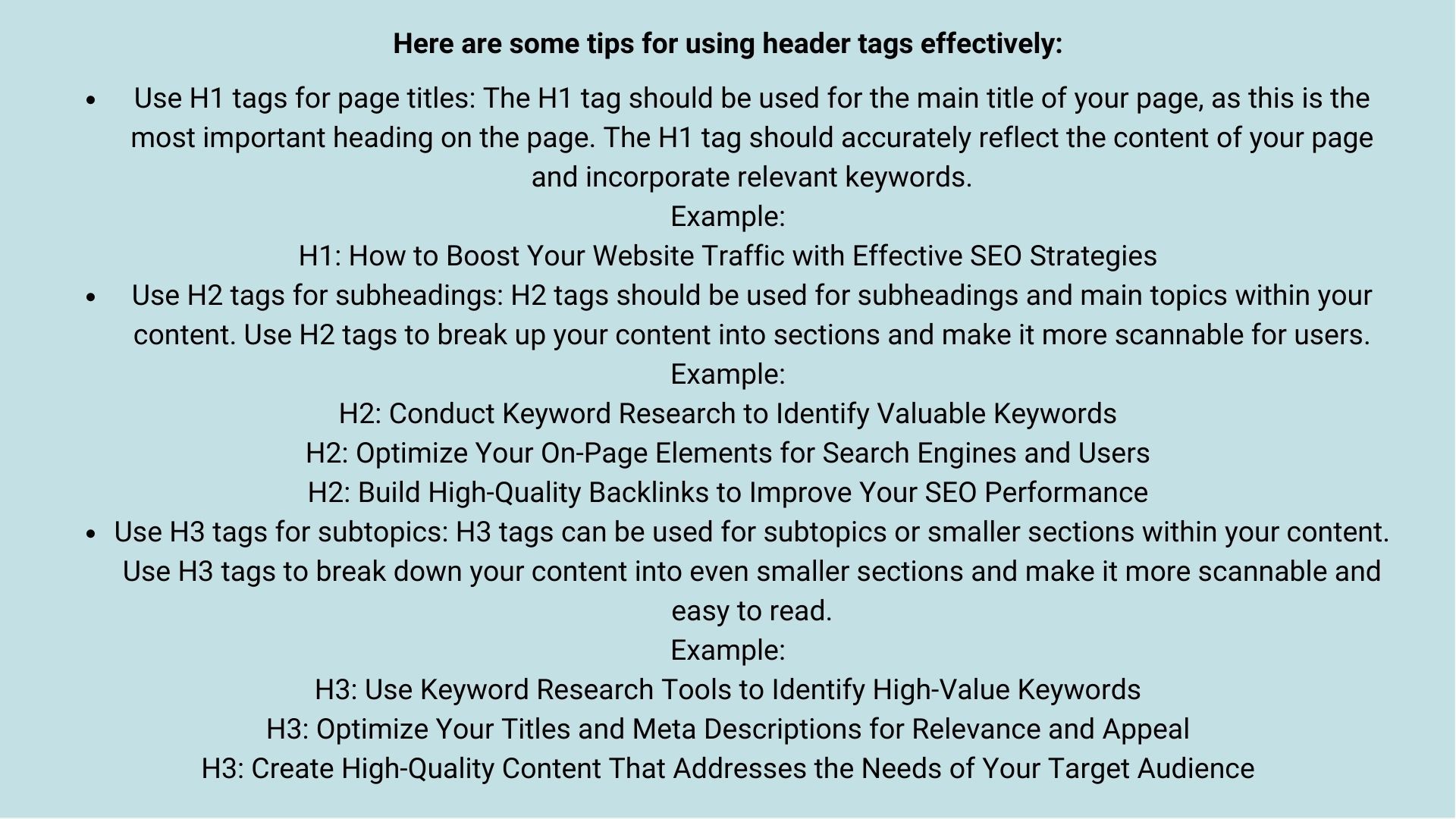
Off-page SEO
Off-page optimization is the term for SEO tactics and strategies used to raise your website's search engine rating outside of your website. Building trustworthy backlinks and social signals from other respectable websites and online platforms are a part of this.
Off-page optimization is vital for SEO since search engines analyze the number and quality of backlinks pointing to your website as a key component in establishing its authority and relevance. Search engines understand that your website is a reliable source of information when other websites connect to it.
High-quality backlinks
One of the most crucial components of off-page optimization is the creation of high-quality backlinks. Search engines understand that your website is a valuable resource when you obtain backlinks from well-known and authoritative websites in your business or area.
These backlinks are seen by search engines as a recommendation for your website and a sign that other websites find your material to be useful and relevant.
To accelerate this process, many businesses rely on a trusted link building agency that helps them secure backlinks from authoritative sites while maintaining compliance with search engine guidelines.
These backlinks are seen by search engines as a recommendation for your website and a sign that other websites find your material to be useful and relevant.
But not every backlink is made equal. While constructing backlinks, it's crucial to prioritize quality over number because an abundance of low-quality links will actually lower your website's search engine position.
In truth, search engines have improved in recent years and can now recognize and penalize websites that use questionable link-building techniques.
So how can you get backlinks of good quality? Here are some pointers:
Make excellent content
Creating valuable, informative, and entertaining content is the best strategy to obtain backlinks. Blog articles, infographics, videos, and other forms of information that your target audience will find useful could be used for this.
Reaching out to other websites
Once you have produced high-quality content, go out to other websites in your sector or niche. Before connecting, identify which websites hold strong domain authority. A simple way to do this is by evaluating each website through Prepostseo. After finding authoritative sites, offer to work together on the content or submit a guest post. This is a terrific approach to collaborating with other website owners while also gaining backlinks.
Keep an eye on your link profile
It's crucial to regularly check your backlink profile to make sure you aren't getting links from spammy or low-quality websites. To safeguard your website's ranking, use tools like Google Search Console or Ahrefs to find any harmful backlinks and remove them.
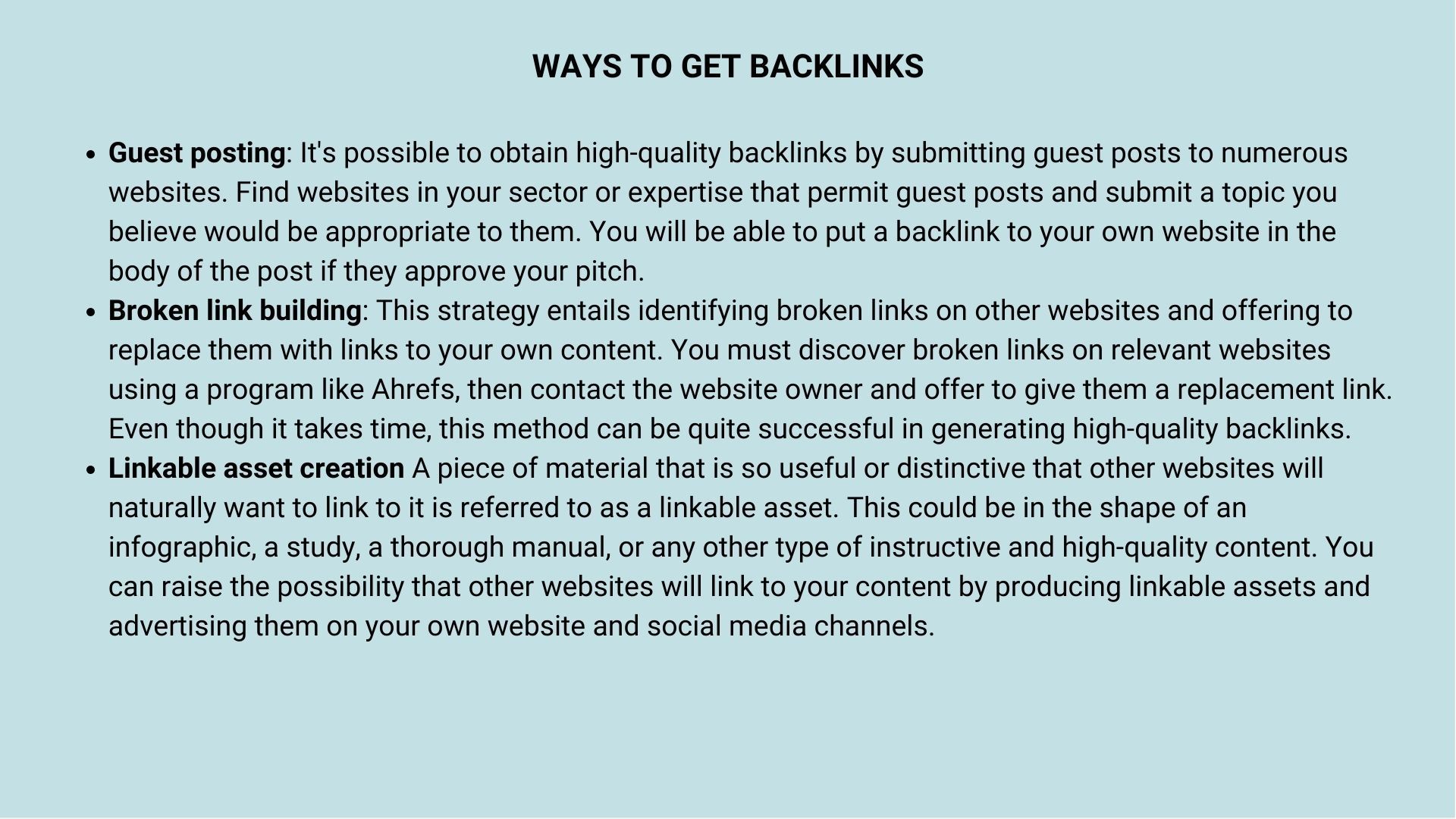
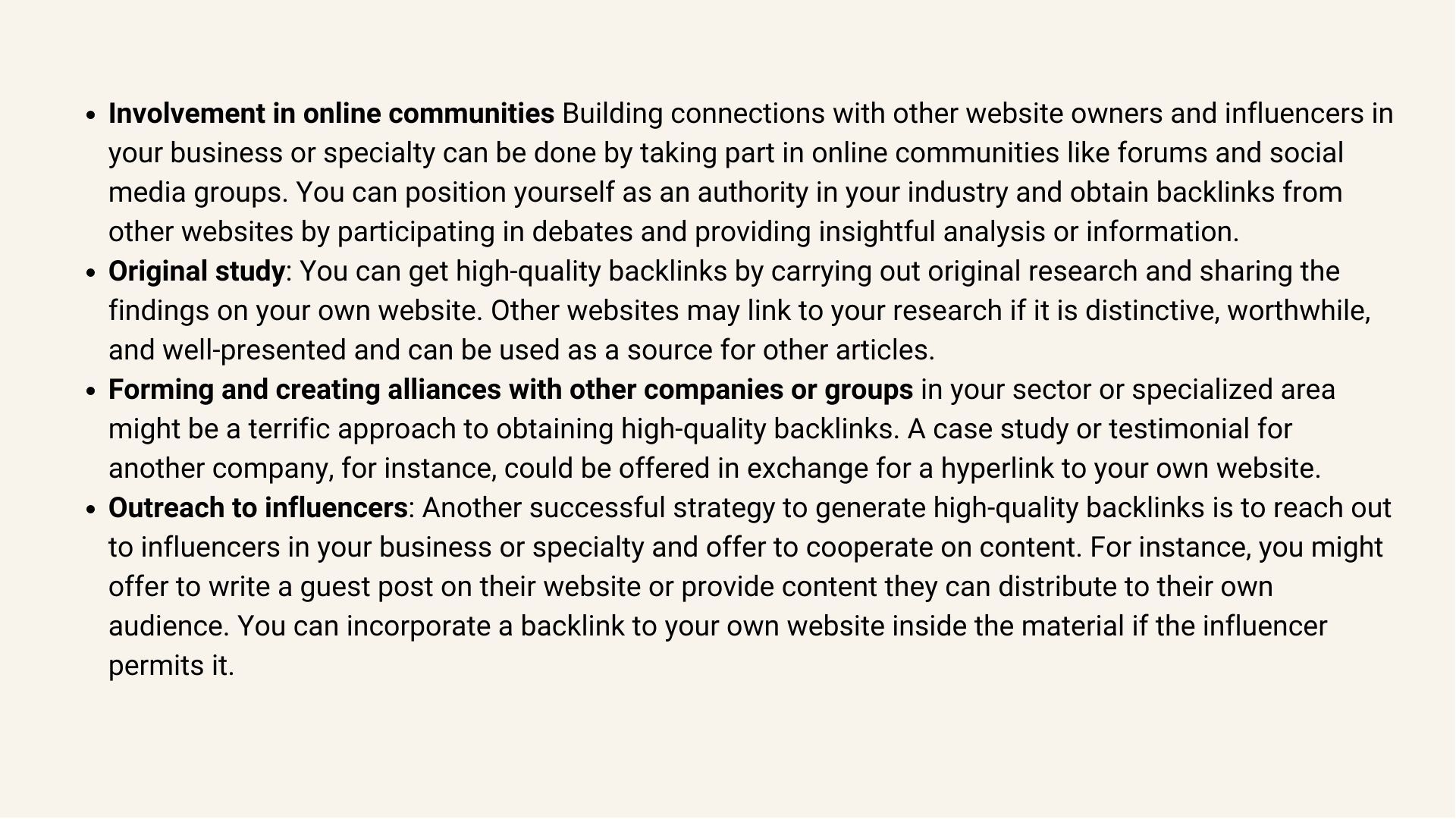
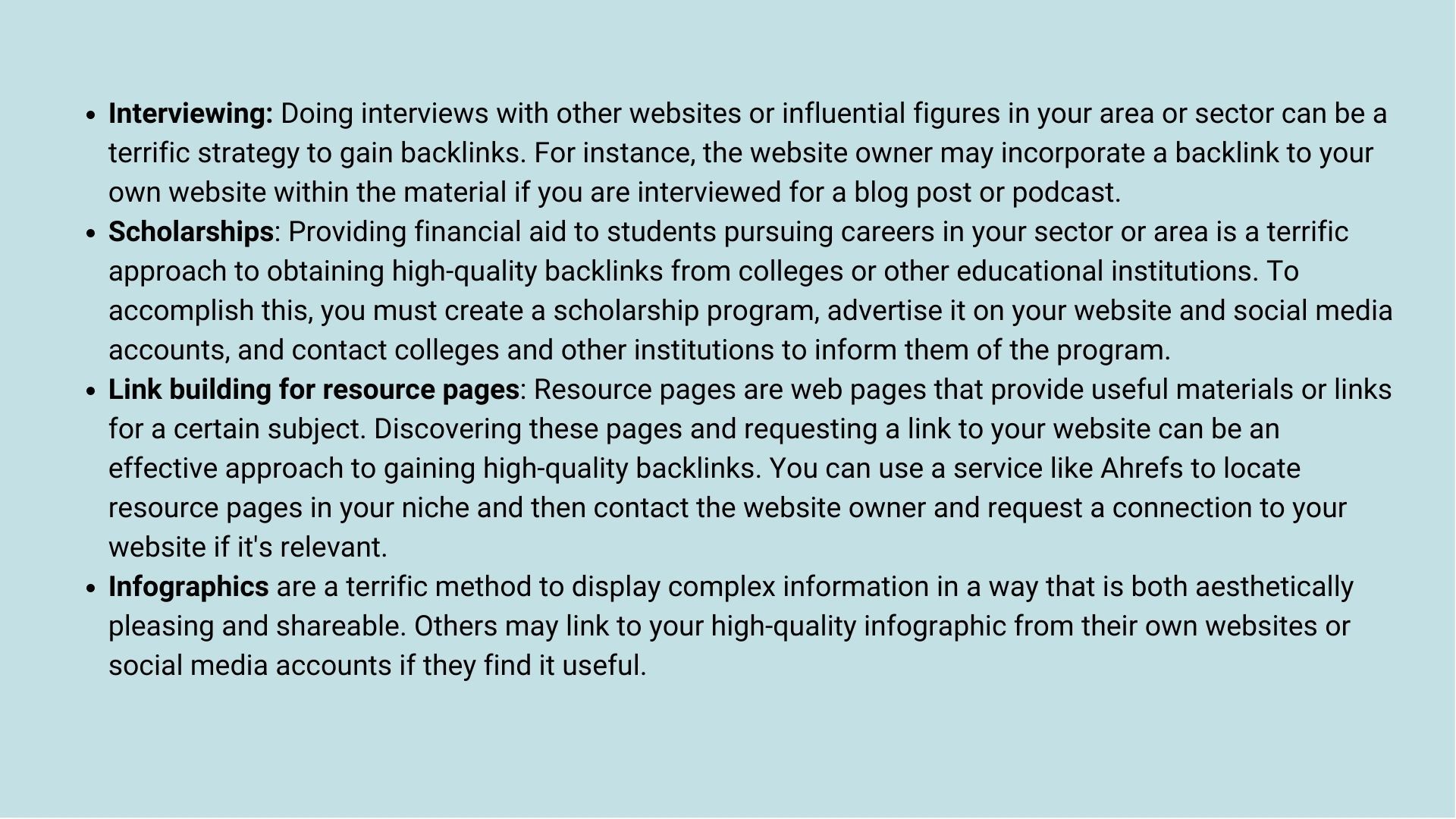
Social signals
Off-page optimization, which can improve your website's search engine performance and increase visitors, heavily relies on social signals. Search engines see your material as useful and well-liked when users interact with it on social media sites like Facebook, Twitter, and Instagram.
The following are some of the ways that social signals may affect how well search engines rank your website:
Likes and shares
Search engines can determine the popularity and value of your material by looking at the likes and shares you receive on social media. Those who like or share your material do so because they think it is valuable or fascinating and wants to spread the word to their own following. This might expand the audience for your content and drive more visitors to your website.
Search engines like Google utilize sophisticated algorithms to assess the authority and relevance of websites, and one of the variables they take into account is social signals. Search engines can tell that your material is popular and valuable if it obtains a lot of likes and shares on social media. When people search for keywords relating to your content, your website may be more likely to show up higher in search results as a result of this, helping to increase its search engine rating.
It's crucial to remember that not all likes and shares are made equal, either. When determining the relevance and authority of a website, search engines like Google also take into account the quality of the social signals. For instance, likes and shares from reputable social media profiles or websites tend to be worth more than those from spammy or unreliable sources.
Comments and conversations
Another method of social validation that can assist in establishing your website as a leader in your sector is comments and conversations on social media. When readers interact with your content by posting comments, posing queries, or joining debates, it demonstrates that your audience finds it important and pertinent. Increased legitimacy and trust may result from this, increasing the number of backlinks and social media shares.
Other industry influencers may get interested in your material as a result of social media engagement from your audience. Influencers are persons with huge social media followings who can help spread the word about your work to more people. You may establish connections with influencers and increase the number of backlinks and social shares that your website receives by taking part in discussions and posting insightful comments on their material.
When determining the authority and relevancy of a website, search engines like Google also take into account the remarks and conversations posted on social media. It tells search engines that your material is useful and relevant when it receives a lot of interaction from reputable sources. When people search for keywords relating to your content, your website may be more likely to show up higher in search results as a result of this, helping to increase its search engine rating.
Follower count and engagement rate
Two important variables that can affect your website's search engine ranking are follower count and engagement rate. Search engines recognize your business as popular and pertinent to your sector when you have a sizable following on social media. This can improve the search engine rating of your website and increase the likelihood that it will show up higher in search results.
Engagement rate is another significant metric that search engines take into account, in addition to follower count. The percentage of your followers who interact with your content on social media, such as by liking, sharing, or commenting on your posts, is referred to as your engagement rate. Search engines can tell that your material is important and interesting to your audience when you have a high engagement rate. This can improve the search engine rating of your website and increase the likelihood that it will show up higher in search results.
Search engines view businesses with enormous followings and high interaction rates as more authoritative and relevant. Search engines aim to give their users the most relevant and worthwhile results possible, and businesses that have sizable followings and high engagement rates are more likely to do so.
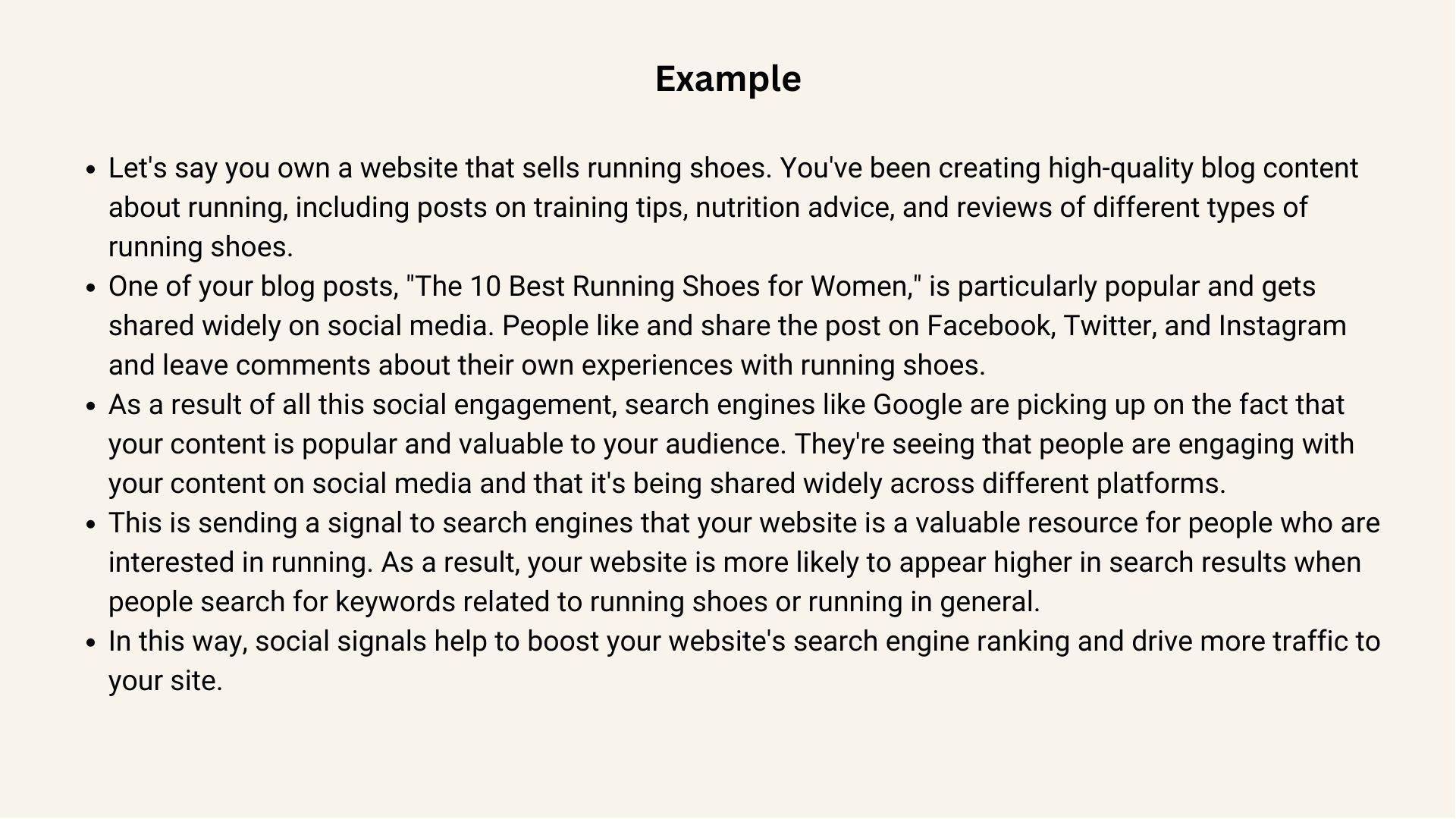
If you are looking to jump into the world of influencer marketing connect with Social Cat for a complimentary trial or book a demo and learn how to work with micro-influencers to boost your brand.
Content creation
Since search engines like Google give preference to websites with high-quality, relevant content when ranking websites, content production is an essential component of SEO. Your website's search engine ranking can be enhanced by producing interesting content that is optimized for both readers and search engines. This will increase traffic to your website.
The following are some methods for producing interesting material that is suitable for both readers and search engines:
Utilize internal linking
Internal linking is the practice of including links within your content to other web pages on your website. This can aid in creating a clear hierarchy and structure for your website and assist in directing visitors to other pertinent content on it. Also, it might make it simpler for search engines to index and rank your content by assisting them in understanding the connections between the various pages on your website.
Analyze your competitors' content
You can learn about the subjects and content types your rivals are producing by conducting a competitor analysis. This can help you generate content that is similar to but better than your competitors' content, offering more value to your audience and enhancing your website's search engine rating.
Update and repurpose outdated content
Repurposing and updating outdated material can be a terrific method to give old posts new life and increase site traffic. You can generate new, interesting content that is optimized for readers and search engines by upgrading older pieces with new data or statistics or repurposing older posts as videos or infographics. This can help boost your website's search engine rating and generate more traffic to your site.
Do keyword research
Prior to writing any content, it's crucial to carry out keyword research to determine the terms and expressions that people are using to look up issues relating to your business. This can assist you in producing content that is search engine optimized and more likely to turn up in search results.
Write for your audience
While it's crucial to produce material that is search-engine-optimized, it's just as crucial to writing for your readership. This entails producing material that is engaging, educational, and pertinent to your audience.
Formatting strategies
Making your material more legible and interesting for readers can be accomplished by using formatting strategies like subheadings, bullet points, and numbered lists. Also, it might make it simpler for search engines to index and rank your material by assisting them in understanding its structure and hierarchy.
Use multimedia components
Making use of multimedia components like infographics, movies, and photographs helps increase the shareability and engagement of your content. Long passages of text can be broken up with it to make your writing more readable for both readers and search engines.
Strive for backlinks with high authority
Producing high-quality content can assist in gaining backlinks from other trustworthy websites in your sector. Producing shareable and worthwhile content can help your website rise in search engine results because backlinks play a significant role in assessing its authority and relevance.
Employ long-tail keywords
Long-tail keywords are longer, more precise keyword phrases that people use to search for specialized topics. By including long-tail keywords in your content, you may help your material appear in more targeted search results and attract more qualified traffic to your site.
Optimize for highlighted snippets
In response to a search query, text snippets called "featured snippets" are displayed at the top of search results. You may improve your site's exposure in search results and draw more visitors by optimizing your content for featured snippets. Use formatting strategies like subheadings and bullet points to make your content easier for search engines to skim in order to optimize for featured snippets. Your content should provide succinct, authoritative answers to frequently asked issues in your sector.
Advanced SEO Techniques
Local SEO
The method of optimizing your website to show up in local search results is known as local SEO. For companies that have a physical location, including restaurants, shops, and service providers, this is especially crucial. Creating a Google My Business page, optimizing your website for local keywords, and constructing local backlinks are all examples of local SEO tactics.
Voice search optimization
As voice searches grow in popularity, you can increase website traffic by making your site more voice-search friendly. Using natural language and a conversational tone in your material, as well as preparing your website for local search, are all examples of voice search optimization approaches.
Featured snippets optimization
In response to a search query, featured snippets are text excerpts that display at the top of search results. You may boost your site's traffic and exposure in search results by optimizing your content for featured snippets. Offering succinct, knowledgeable responses to frequently asked questions about your sector, using formatting tricks like subheadings and bullet points, and making your website mobile-friendly are all examples of strategies for featured snippets optimization.
More sophisticated SEO strategies include:
Schema markup
Schema markup is a sort of coding that facilitates search engines' comprehension of the content on your website. You may raise your website's search engine rating and increase traffic by adding schema markup to your site.
Accelerated Mobile Pages
The technology known as Accelerated Mobile Pages (AMP) makes it possible for web pages to load more quickly on mobile devices. You may increase the performance of mobile searches for your website and drive more visitors to it by optimizing it for AMP.
Artificial Intelligence (AI) and machine learning
As search engines like Google employ these technologies to comprehend and rank websites, AI and machine learning are becoming more and more significant in SEO. The usage of natural language in your content as well as the creation of high-quality, pertinent information, are all methods for optimizing for AI and machine learning.
SEO Tools and Resources
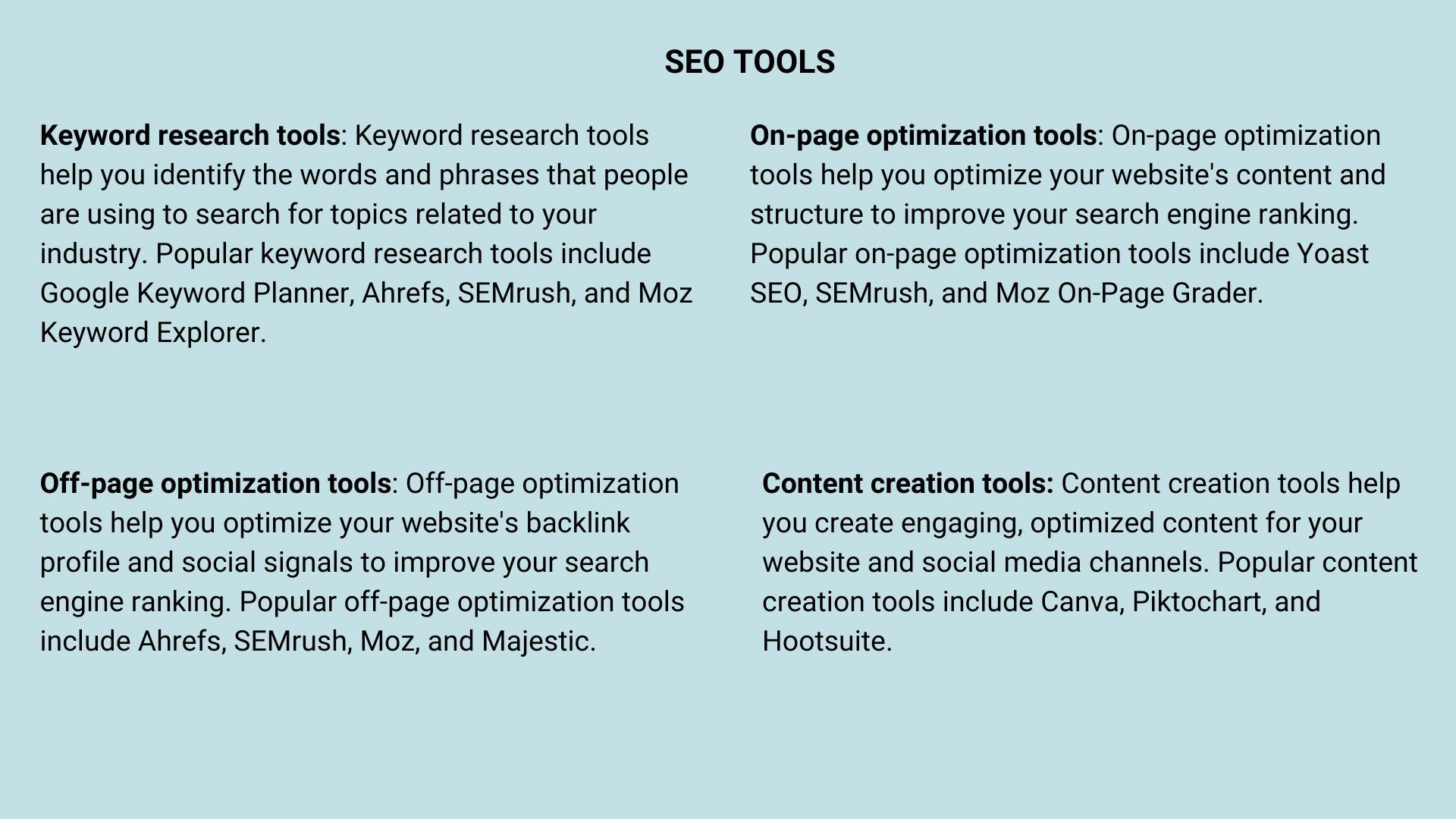
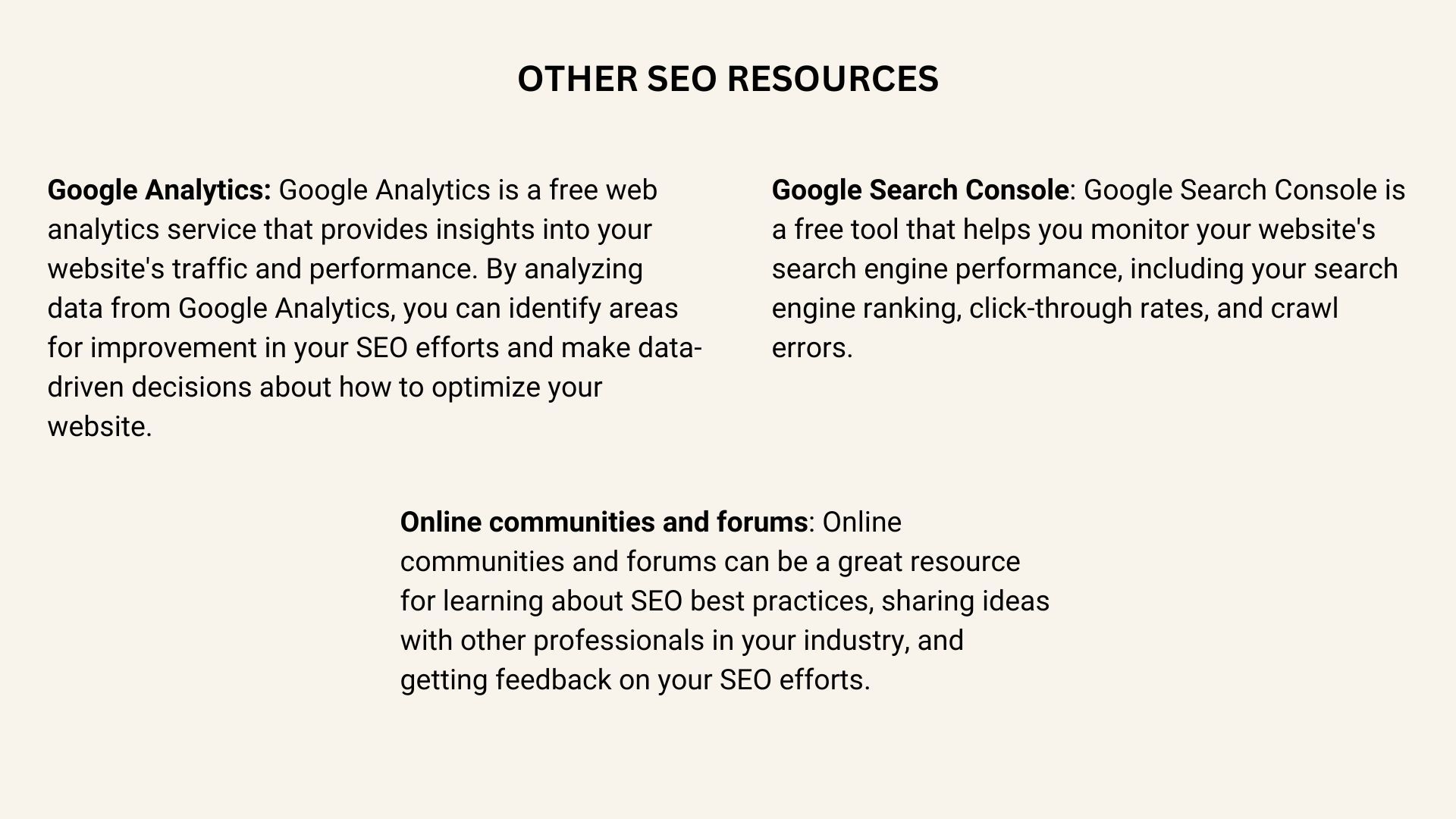
Conclusion
Any effective internet marketing plan must include search engine optimization (SEO). In order to increase your website's visibility in search engine results pages (SERPs) and drive more traffic to it, SEO entails optimizing the content, structure, and backlink profile of your website.
Making sure that your website offers value to users and search engines alike is at the heart of SEO. You can make sure that search engines can comprehend and rank your material efficiently by conducting keyword research and optimizing your content and structure for those keywords.
Also, you may increase traffic to your website and raise its authority and relevance in the eyes of search engines by producing interesting, worthwhile content that connects with your audience and encourages social sharing and backlinking.










